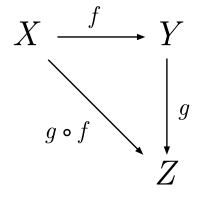Applied category theory
Applied category theory is an academic discipline in which methods from category theory are used to study other fields[1][2][3] including but not limited to computer science,[4][5] physics (in particular quantum mechanics[6][7][8]), control theory,[9][10] natural language processing,[11][12] probability theory and causality. The application of category theory in these domains can take different forms. In some cases the formalization of the domain into the language of category theory is the goal, the idea here being that this would elucidate the important structure and properties of the domain. In other cases the formalization is used to leverage the power of abstraction in order to prove new results about the field.
External links
Journals:
Conferences:
- Applied category theory
- Symposium on Compositional Structures (SYCO)[13]
Books:
References
- "Applied Category Theory". MIT OpenCourseWare. Retrieved 2019-07-20.
- Spivak, David I.; Fong, Brendan (July 2019). An Invitation to Applied Category Theory by Brendan Fong. doi:10.1017/9781108668804. ISBN 9781108668804.
- Bradley, Tai-Danae (2018-09-16). "What is Applied Category Theory?". arXiv:1809.05923v2. Cite journal requires
|journal=(help) - Barr, Michael. (1990). Category theory for computing science. Wells, Charles. New York: Prentice Hall. ISBN 0131204866. OCLC 19126000.
- Ehrig, Hartmut; Große-Rhode, Martin; Wolter, Uwe (1998-03-01). "Applications of Category Theory to the Area of Algebraic Specification in Computer Science". Applied Categorical Structures. 6 (1): 1–35. doi:10.1023/A:1008688122154. ISSN 1572-9095.
- Abramsky, Samson; Coecke, Bob (2009), "Categorical Quantum Mechanics", Handbook of Quantum Logic and Quantum Structures, Elsevier, pp. 261–323, arXiv:0808.1023, doi:10.1016/b978-0-444-52869-8.50010-4, ISBN 9780444528698
- Duncan, Ross; Coecke, Bob (2011). "Interacting Quantum Observables: Categorical Algebra and Diagrammatics". New Journal of Physics. 13 (4): 043016. arXiv:0906.4725. Bibcode:2011NJPh...13d3016C. doi:10.1088/1367-2630/13/4/043016.
- Coecke, Bob. (2017-03-16). Picturing quantum processes : a first course in quantum theory and diagrammatic reasoning. ISBN 978-1107104228. OCLC 1026174191.
- Master, Jade; Baez, John C. (2018-08-16). "Open Petri Nets". arXiv:1808.05415v4. Cite journal requires
|journal=(help) - Baez, John C.; Pollard, Blake S. (2018). "A compositional framework for reaction networks". Reviews in Mathematical Physics. 29 (9): 1750028–425. arXiv:1704.02051. Bibcode:2017RvMaP..2950028B. doi:10.1142/S0129055X17500283. ISSN 0129-055X.
- Kartsaklis, Dimitri; Sadrzadeh, Mehrnoosh; Pulman, Stephen; Coecke, Bob (2016), "Reasoning about meaning in natural language with compact closed categories and Frobenius algebras", Logic and Algebraic Structures in Quantum Computing, Cambridge University Press, pp. 199–222, arXiv:1401.5980, doi:10.1017/cbo9781139519687.011, ISBN 9781139519687
- Grefenstette, Edward; Sadrzadeh, Mehrnoosh; Clark, Stephen; Coecke, Bob; Pulman, Stephen (2014), "Concrete Sentence Spaces for Compositional Distributional Models of Meaning", Text, Speech and Language Technology, Springer Netherlands, pp. 71–86, arXiv:1101.0309, doi:10.1007/978-94-007-7284-7_5, ISBN 9789400772830
- "The n-Category Café". golem.ph.utexas.edu. Retrieved 2019-07-20.
